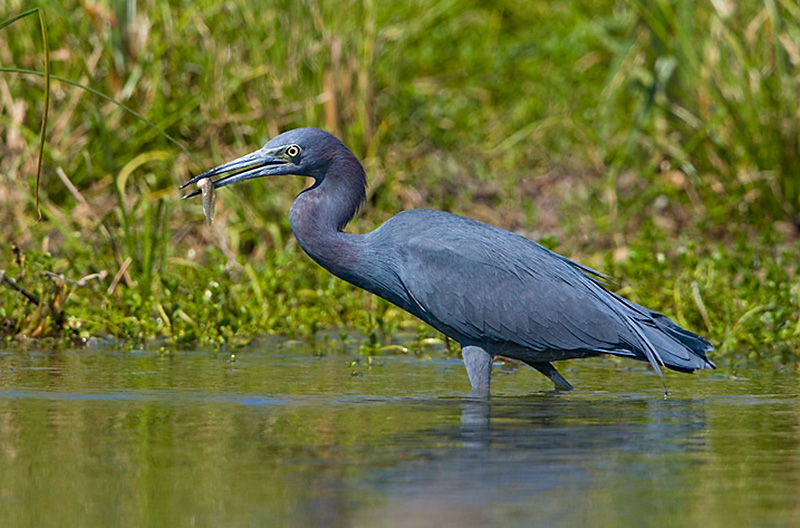Little Blue Heron is a medium-large, long-legged, darkly colored bird from the Ardeidae family.
This bird can be seen in both saltwater and freshwater ecosystems in the southeastern United States, Central America, northern South America, and numerous Caribbean islands.
If you’ve seen a peculiar bird with those colors carefully wading in shallow water, extending its neck like a telescope to see what’s going on under the surface, then this might’ve been a Little Blue Heron. It is one of the smaller herons out there and quite common within its range.
Identification
Both the female and male Little Blue Heron look the same, except the female is slightly smaller. In a good light, its body appears grayish-blue, and its long neck grayish-purple. They like to keep their neck in an S-shape while resting or flying but stretch it out when they’re hunting.
The bird has long greenish legs, yellow eyes, and a long and slender grayish or pale blue bill that is tipped with black. Little Blue Herons can grow 22-29 inches long, weigh around 14 oz, and have a wingspan of 39-41 inches.
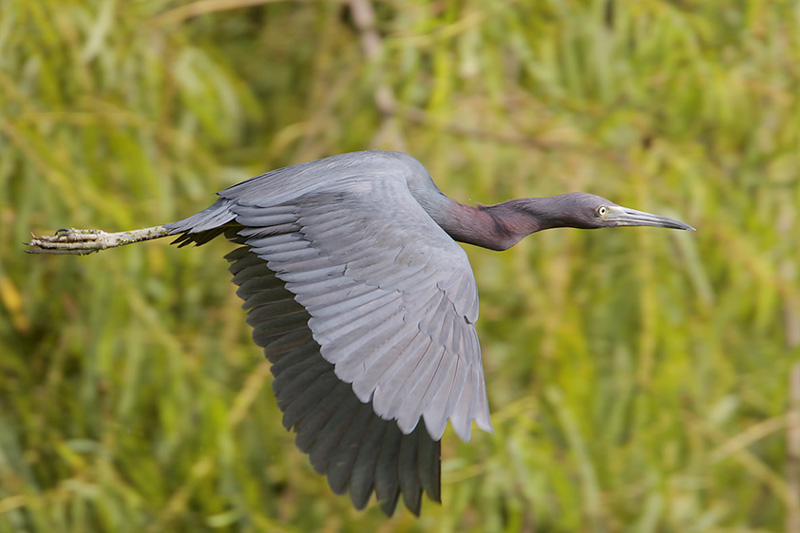
Little Blue Heron in flight
Juvenile Little Blue Herons differ drastically from their parents. They are completely white, save for some specks of gray on their wingtips and the tip of their bill, which is black, and they have light greenish legs. Their different appearance offers juveniles more protection against predators because they can integrate with flocks of other herons. Immature Little Blue Herons that are just molting into their adult plumage are a mishmash of white and grayish-blue.
If you happen to see a Little Blue Heron flying, you can recognize it by its broad and rounded wings with its neck curled into an S-shape, and legs dangling well beyond its short and rounded tail.
Little Blue Herons are graceful, unenergetic, and quiet birds. You can see them walking carefully and quietly around marshes, flooded fields, edges of lakes, and other wetlands. They don’t make much sound but are known to clack their bills to communicate.
Food
Little Blue Herons are carnivorous, specifically piscivorous. They eat different fish, snakes, frogs, lizards, crabs, shrimp, aquatic insects, and spiders, but also grasshoppers, beetles, and other grassland insects when the water retreats.
Little Blue Herons forage and hunt during the day. They walk slowly in the water, often standing motionless, searching and stalking for prey. They rake the ground with their foot to disturb it, stretching their neck so they can look at what is going on under the surface. Once found, they catch their prey with their long bill.
Juvenile Little Blue Herons can be seen looking for food alongside Snowy Egrets. Snowy Egrets tolerate juveniles because they have a similar appearance, and the juvenile Little Blue Herons find more fish in their company.
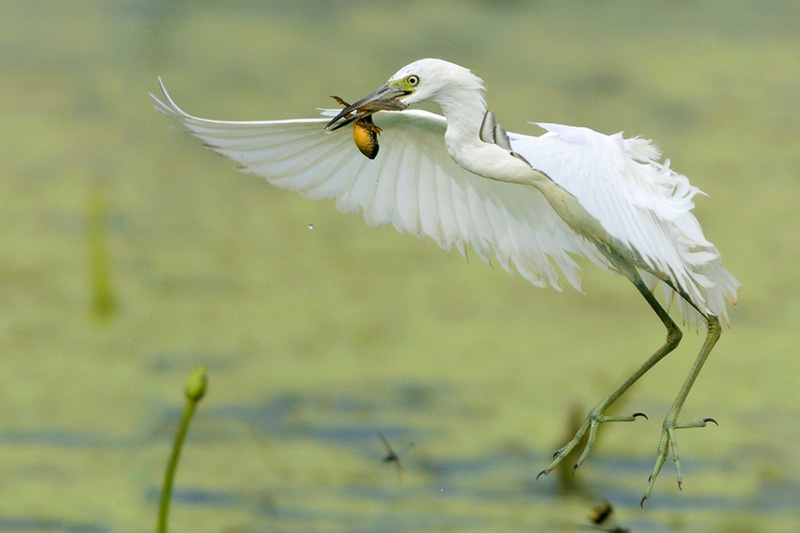
Juvenile Little Blue Heron
Nesting and Eggs
Little Blue Herons are monogamous, they mate for life and nest in colonies. Typically, an unpaired male arrives at the breeding area to claim a small territory for himself, then puts on a display to attract females. This involves the male raising his crest and neck feathers, stretching his neck up and then retracting it back down.
This is one of the rare times Little Blue Herons make sounds, which include bill clacking and hoarse squawks and croaks. A female approaches him if the display has impressed her and after a while, they can be seen nibbling each other’s feathers and crossing their necks.
Little Blue Herons nest in shrubs and small trees 3-15 feet above the ground. They may also choose flooded areas or islands for extra protection. After pairing, both the male and female build a big, flimsy platform of a nest from twigs and may line it with softer material and feathers.
The female, on average, lays 3-5 pale blue-green eggs, that are 1.6-2 inches long and 1.2-1.4 inches wide. The pair takes turns incubating the eggs, which takes from 22 to 23 days. The chicks stay in the nest for 35-49 days. They are fiercely competitive for food and may sometimes attack and kill their smaller nestmates.
After nesting, the colonies disperse, and the birds fly away in all directions.
Current Situation
Little Blue Herons range from the southeastern United States to Central America and northern South America. They can be found in various salt- and freshwater ecosystems, including swamps, lakes, canals, ditches, flooded fields, marshes, ponds, streams, lagoons, and shores.
They are listed as Least Concern in the IUCN Red List but in some coastal areas, they are listed as of special concern.
This is due to their loss of clean, undisturbed wetland habitats and, in turn, loss of colonies. Cutting forests and draining ponds, lakes, and wetlands is a major problem for these birds, as they are either being disturbed, or they lose their habitats altogether. Pesticides have caused their eggshells to thin. Little Blue Herons are also threatened by other, more aggressive heron species, that outcompete them for food.
Today, although their population is still large, their overall numbers are decreasing.
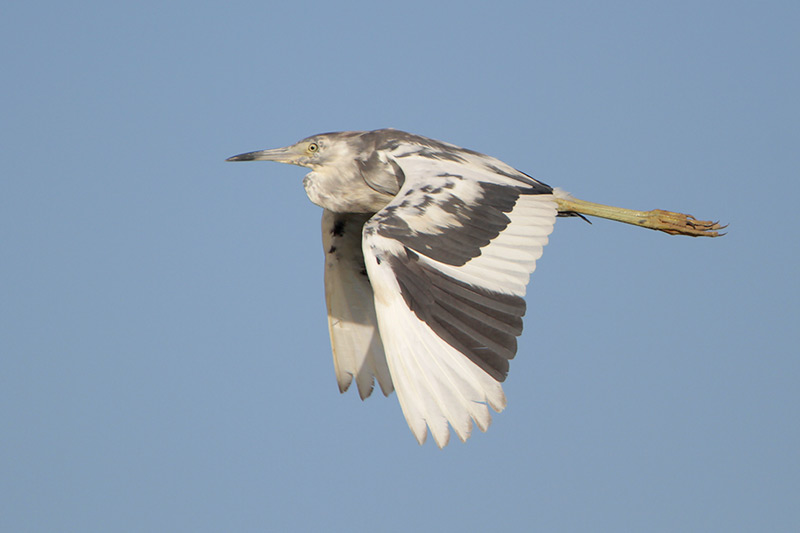
As Little Blue Herons molt into adult plumage they go through a phase with a Pied plumage. Photograph © Greg Lavaty.
Facts
- Little Blue Herons have a row of “teeth” along their middle toe. They use this “comb” to scratch their head, neck, and throat.
- In the late 19th and early 20th centuries, the heron and egret species were hunted for their colorful plumage. The Little Blue Heron escaped it thanks to their dull plumage.
- Some tribes in North America consider the Little Blue Heron as a symbol of good luck and patience.
- The female Little Blue Heron lays its eggs over a period of several days. They start the incubation process when two eggs have been laid, meaning some chicks hatch later. The older chicks are usually bigger and stronger, demanding food for themselves and attacking their smaller and weaker siblings, sometimes killing them.
Similar Species
There are three species that are quite similar to the Little Blue Heron but worry not, you can distinguish them upon taking a closer look.
Snowy Egret
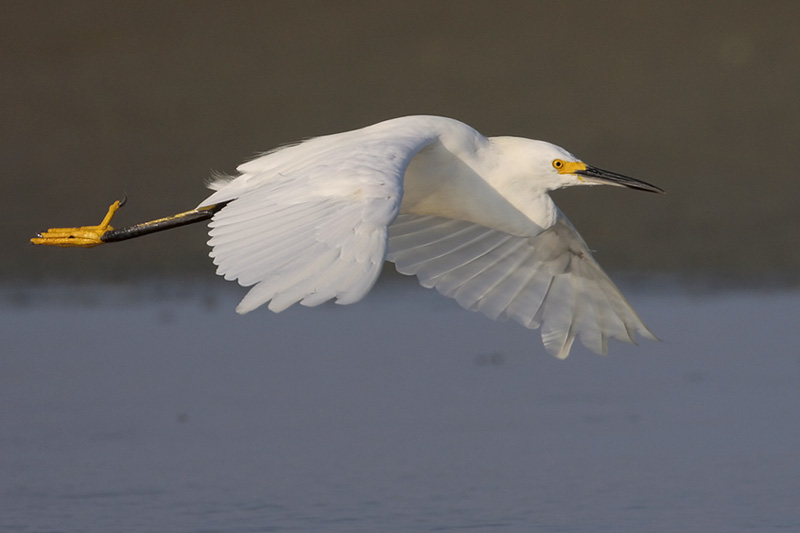
You can mistake a juvenile Little Blue Heron for a Snowy Egret because both have all-white plumage.
However, the Snowy Egret has an all-black bill, black legs, and yellow feet, whereas a juvenile Little Blue Heron has light green legs and a two-toned bill.
Related: Egret vs Heron
Reddish Egret
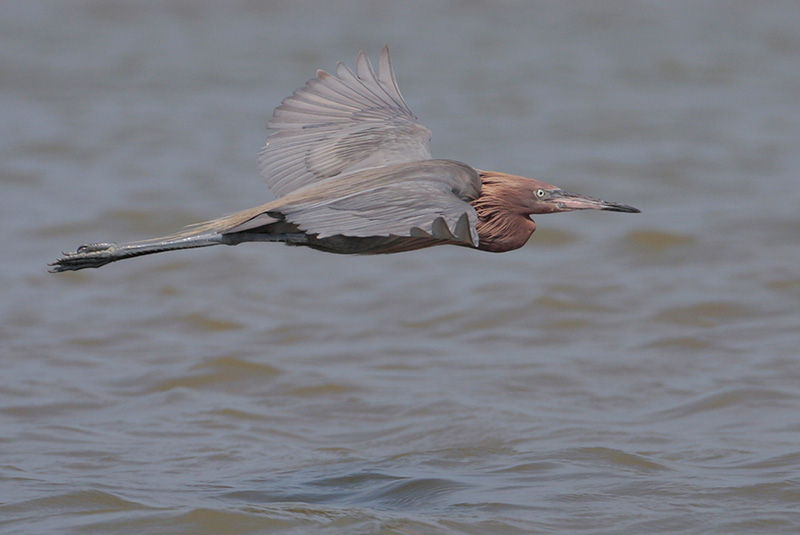
These birds look very similar but they have their differences. A Reddish Egret is larger than a Little Blue Heron and they have rusty-colored necks, whereas a Little Blue Heron has a grayish-purple neck.
Reddish Egret also has a white morph that is similar to the juvenile Little Blue Heron, but the Egret has darker, almost black legs and a pink base to their bill instead of the grayish blue that the Little Blue Heron has.
Tricolored Heron
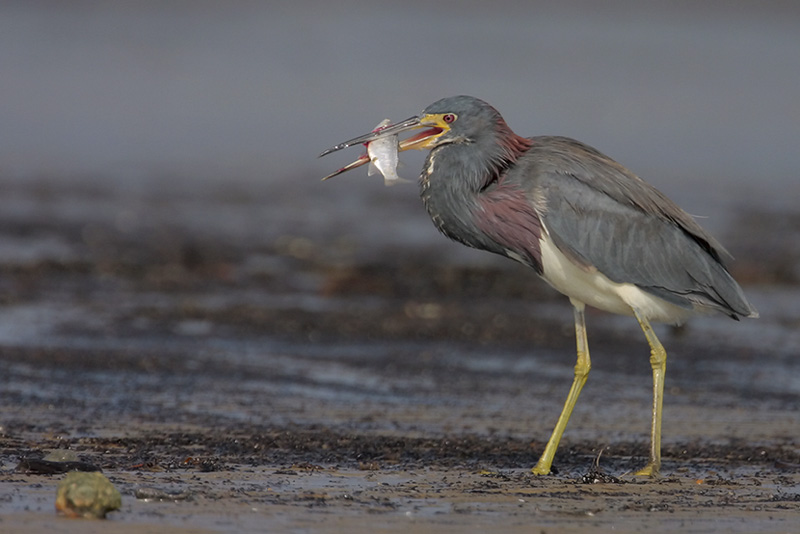
Overall, they have the same colors, but the Tricolored Heron has a white underbelly and a white stripe down their neck.
Tricolored Heron also has red eyes as opposed to Little Blue Heron’s yellow ones, and the upper part of their bill is black, the lower part yellow, whereas the Little Blue Heron’s bill is evenly colored grayish-blue with a black tip.
Read Also: Egret and Heron – Bill Comparison
FAQ
Are Little Blue Herons rare?
Little Blue Herons are quite common in their range and are classified as Least Concern in the IUCN Red List. However, the Florida Fish and Wildlife Conservation Commission has listed the species as a Species of Special Concern, as it is somewhat rare in some parts of Florida.
Where are Little Blue Herons found?
Little Blue Herons can be found in both salt- and freshwater ecosystems. They prefer freshwater wetlands, such as marshes, lakes, and ponds, but also flooded grasslands, or marine coastlines.
How do you identify a Little Blue Heron?
You can identify a Little Blue Heron by its appearance. Adult Little Blue Herons have dark grayish-blue plumage, a long grayish-purple neck they like to keep in an S-shape, long greenish legs, yellow eyes, and a long and slender grayish-blue bill with a black tip. Juvenile Little Blue Herons are all-white and might be confused with Snowy Egrets.
What is the average lifespan of a Little Blue Heron?
The average lifespan of a Little Blue Heron is around 13-14 years.

